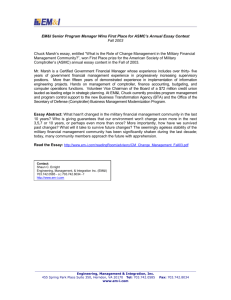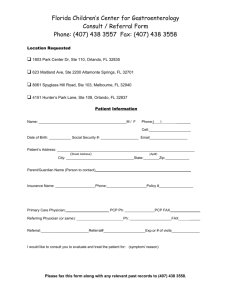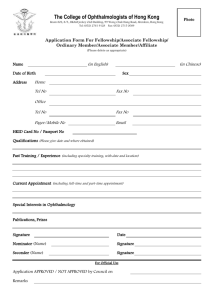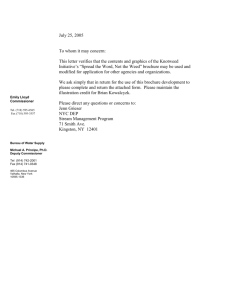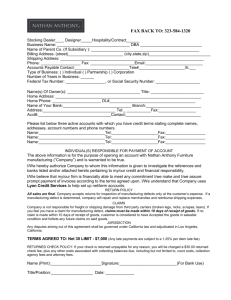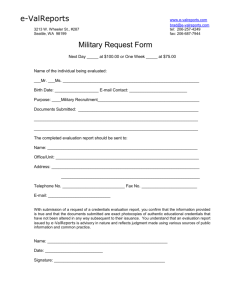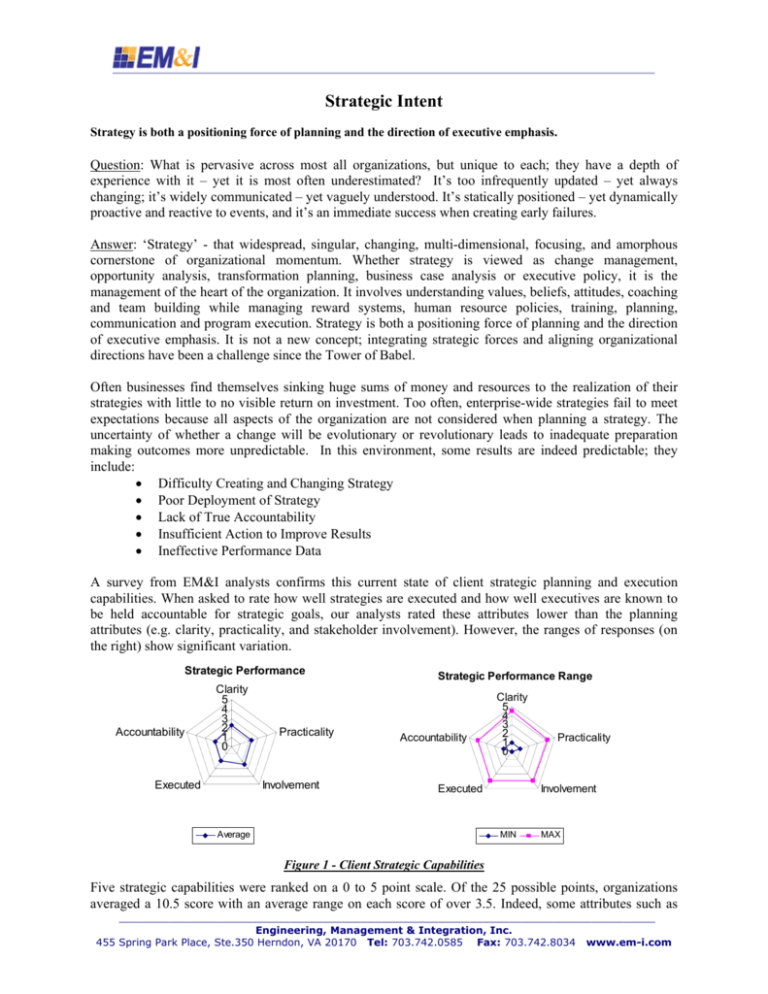
Strategic Intent
Strategy is both a positioning force of planning and the direction of executive emphasis.
Question: What is pervasive across most all organizations, but unique to each; they have a depth of
experience with it – yet it is most often underestimated? It’s too infrequently updated – yet always
changing; it’s widely communicated – yet vaguely understood. It’s statically positioned – yet dynamically
proactive and reactive to events, and it’s an immediate success when creating early failures.
Answer: ‘Strategy’ - that widespread, singular, changing, multi-dimensional, focusing, and amorphous
cornerstone of organizational momentum. Whether strategy is viewed as change management,
opportunity analysis, transformation planning, business case analysis or executive policy, it is the
management of the heart of the organization. It involves understanding values, beliefs, attitudes, coaching
and team building while managing reward systems, human resource policies, training, planning,
communication and program execution. Strategy is both a positioning force of planning and the direction
of executive emphasis. It is not a new concept; integrating strategic forces and aligning organizational
directions have been a challenge since the Tower of Babel.
Often businesses find themselves sinking huge sums of money and resources to the realization of their
strategies with little to no visible return on investment. Too often, enterprise-wide strategies fail to meet
expectations because all aspects of the organization are not considered when planning a strategy. The
uncertainty of whether a change will be evolutionary or revolutionary leads to inadequate preparation
making outcomes more unpredictable. In this environment, some results are indeed predictable; they
include:
• Difficulty Creating and Changing Strategy
• Poor Deployment of Strategy
• Lack of True Accountability
• Insufficient Action to Improve Results
• Ineffective Performance Data
A survey from EM&I analysts confirms this current state of client strategic planning and execution
capabilities. When asked to rate how well strategies are executed and how well executives are known to
be held accountable for strategic goals, our analysts rated these attributes lower than the planning
attributes (e.g. clarity, practicality, and stakeholder involvement). However, the ranges of responses (on
the right) show significant variation.
Strategic Performance
Accountability
Clarity
5
4
3
2
1
0
Executed
Practicality
Involvement
Strategic Performance Range
Accountability
Clarity
5
4
3
2
1
0
Executed
Average
Practicality
Involvement
MIN
MAX
Figure 1 - Client Strategic Capabilities
Five strategic capabilities were ranked on a 0 to 5 point scale. Of the 25 possible points, organizations
averaged a 10.5 score with an average range on each score of over 3.5. Indeed, some attributes such as
____________________________________________________________________________________
Engineering, Management & Integration, Inc.
455 Spring Park Place, Ste.350 Herndon, VA 20170 Tel: 703.742.0585 Fax: 703.742.8034 www.em-i.com
heavy stakeholder involvement which is desirable for a mature organization would be less desirable for
some organizational cultures where a dictated strategy would be more accepted, consistent, and
understood. These preliminary results reflect a wide range of unique strategic improvements needed in
just EM&I clients. A larger population sample is unlikely to alter this finding.
These five attributes are not a complete assessment of strategic capabilities. Additional, characteristics
and capabilities were identified (e.g., unification, completeness, mapping strategies to organizational
departments, coherence, economical, proper emphasis, and enabling synergies). EM&I can help
organizations assess their strategic strengths and weaknesses and identify needed improvements, but a
clearer definition is needed to focus efforts.
The cultural context in which strategy is executed has a lot of control over how strategies are perceived
and evaluated. Henry Mintzberg (1994) in, The Rise and Fall of Strategic Planning [1], points out that
people use "strategy" in several different ways:
•
Strategy is a plan, a "how," leaders establish direction and sequence tactics as a means of getting
from here to there.
•
Strategy is a pattern in actions over time; for example, an organization that consistently markets
very expensive products is using a "high end" strategy.
•
Strategy is (competitive) position; it reflects decisions to offer particular products or services in
particular markets to meet, avoid, or subvert the competition.
•
Strategy is perspective, vision and direction that infuse a culture.
Mintzberg believes that strategy emerges over time as intentions accommodate a changing reality. Thus,
one might start with a perspective and conclude that it calls for a certain position, which is to be achieved
by way of a carefully crafted plan, with the eventual outcome and strategy reflected in a pattern evident in
decisions and actions over time. This pattern defines what he calls "realized" or emergent strategy.
In Top Management Strategy [2], Benjamin Tregoe and John Zimmerman define strategy as "the
framework which guides those choices that determine the nature and direction of an organization."
Ultimately, this boils down to selecting products or services to offer and the markets in which to offer
them. Tregoe and Zimmerman urge executives to base these decisions on a single "driving force" of the
business. Although there are nine possible driving forces, they believe that only one can serve as the basis
for strategy for a given business. The nine possibilities are listed below:
1.
2.
3.
4.
5.
6.
7.
8.
9.
Products offered
Market needs
Technology
Production capability
Method of sale
Method of distribution
Natural resources
Size/growth
Return/profit
Most organizations will find a mixture of driving forces exists and will not adequately profile their unique
needs. In fact, organizations typically choose methodologies, technologies, and business solutions that are
successful in other organizations with little or no research into how compatible they are to their own
business environment.
____________________________________________________________________________________
Engineering, Management & Integration, Inc.
455 Spring Park Place, Ste.350 Herndon, VA 20170 Tel: 703.742.0585 Fax: 703.742.8034 www.em-i.com
Effective strategy requires an honest assessment of capabilities and weaknesses of internal and external
resources. Competitive strategy is about being different. Like military strategy, finding a weakness and
getting an advantage in one area enables an organization to optimize resources and leverage that position.
Focus (i.e. both as a narrowing of scope and as an emphasis of attention) creates a niche that distinguishes
an organization to stakeholders, shareholders, and customers.
There is not one solution that can accommodate the diverse needs of the dynamic environment and
multiple perspectives. However, while strategic plans are unique, they do encompass basic patterns of
development. A seven-step outline follows:
Step 1. Establish a Clear Vision
Regardless of where the driving forces for change begin, organizational leaders must build the support
necessary to develop and maintain a mandate. The entire organization must clearly understand the
direction and, perhaps more importantly, what must change. Maintaining support will require frequent
contact between project teams, senior management and stakeholders, as well as communication with the
organization as whole and external partners.
Step 2. Translate the Vision into Manageable Components and Guiding Principles
Vision must be translated and quantified into concrete forms to be deployed. This often takes the form of
a project portfolio. Organizations examine what projects are underway and how they are defined.
Project Definition:
Dimensions – budget, number of people, elapsed time, output delivered, platform
Organization – reporting and control structures
Stages – phases, lifecycle, platform
Number of projects initiated in a year? (by size)
How many projects does an “average” employee work on simultaneously?
What are the defect rates? (pre and post delivery)? (by platform) (by cause)
What are the customer satisfaction levels? How many concurrent users are serviced?
Also, organizational vision statements can benefit from the creation of guiding principles that explicitly
outline core beliefs and assumptions. A few stated philosophies such as “buy before building” or “retrain
before hiring” can ensure that decisions don’t diverge from the original strategic intent.
Break the strategy down into the smallest initiative that measurable value can be achieved and return-oninvestment measured. For each initiative listed:
• Map it to the associated strategy objective
• Identify dependencies on other initiatives
• Estimate level of effort
• Estimate cost
• Estimate return on investment
• Identify how success will be measured
Step 3. Identify Stakeholders
Proper identification of stakeholders is critical to success of strategic plans. Unfortunately, this step is
frequently overlooked or completed haphazardly. Take time to identify the individuals, groups or
institutions with interests in organizational outcomes. Be sure to include both “winners” and “losers”, and
those involved or excluded from decision-making processes. A stakeholder profile along with the project
portfolio form part of a change readiness assessment.
____________________________________________________________________________________
Engineering, Management & Integration, Inc.
455 Spring Park Place, Ste.350 Herndon, VA 20170 Tel: 703.742.0585 Fax: 703.742.8034 www.em-i.com
Step 4. Assess Change Readiness
Completion of a change-readiness assessment or cultural audit will help to determine the organization’s
level of acceptance or resistance to change. Results reveal which areas of the organization may need more
attention from the strategic change program to ensure a successful transition. Results also help to identify
specific organizational issues that the change strategy must address.
Determine the organization’s profile (current and desired)
Attribute
a. Environment/Culture
b. Structure
c. Risk Tolerance
d. Operational Focus
e. Staff Development
f. Leadership style
g. Measure of Success
h. Commitment
Traditional
Stable, Rule-based
Hierarchical, Closed
Maintenance (costcutting)
Plans/Budgets
(sequential)
Career Based, training
Control
Market/Financial Target
Enforcement of
Standards
Transitional
Dynamic, creative
Network, Partnerships
Learning, R&D
(investment)
Output/Growth (insight)
Talent Based, hiring
Influence, Coach
Strategic Momentum
Empowered Individuals
Figure 2 - Profile Organizational Attributes
Not every organization is ready or needs to transition to a dynamic, high risk, agile, or leading-edge
organization overnight. But, determining the current profile and the desired profile enables plans to be
evaluated on contribution toward the desired state, and next steps to be identified and prioritized. The
following categories help identify the desired state and set the stage to determine appropriate tactical next
steps.
a. Environment / Culture: Dynamic
Behavior, perceptions and attitude within the organization support the implementation of change. The
organization's structure, leadership, and processes are aligned with the change.
Change the culture from rule-based to creative
•
Extent to which the organization generally supports change; open culture; degree behavior change
is management led.
Develop & encourage creativity
•
Actively promote an environment for staff to be creative without risk; systematic seeking &
implementation of good practice; new ideas recognized.
Continual organizational learning
•
How the organization learns best practice and lessons from other change initiatives; review stages
& phases; feedback process; up-to-date repository of learning lessons across the organization.
Aligning reward, recognition & people policies
•
Degree 'people' policies and procedures support & reward change; change and project
management skills seen as key competencies in leading organizations.
____________________________________________________________________________________
Engineering, Management & Integration, Inc.
455 Spring Park Place, Ste.350 Herndon, VA 20170 Tel: 703.742.0585 Fax: 703.742.8034 www.em-i.com
b. Structure:
Organizational structure determines communication channels and sets boundaries for performance
measures and accountability. Hierarchical structures are associated with larger operations. More agile
organizations are flatter and promote flexible with supply chain partnerships.
•
Open communication supports employee empowerment
•
Network structures are more easily altered as business needs change.
c. Risk Tolerance:
IT organizations that support business units are often viewed as an overhead expense. Cost-cutting
measures are applied to reduce the expense of IT operations. As IT processes penetrate more business
areas, IT assets and benefits become business investments that influence competitive strategies. Risk
management enables companies to successfully undertake strategies that lead to higher return on IT
investments.
Leading companies encourage risk within a controlled investment plan.
•
E-business technologies
•
Data Warehouse and Knowledge Management
•
Virtual teams and globalization
d. Operational Focus: Team & Project Management
Strategic change is delivered by managing change teams. Change management includes the effective use
of process measures, external input/support and training to facilitate this.
Mobilizing & Managing Teams
•
Team members are selected for required competencies; degree & effectiveness
•
Teams are managed - selection, availability, development, motivation, performance management,
reward and transition out.
Managing Projects & Programs
•
Degree project management disciplines are utilized; consistency across organization.
Aligning Technology & Processes
•
Assessment of project on existing technology, systems or processes; how any impacts are
managed in advance.
Leading companies manage output rather than formalize processes.
e. Staff Development:
The shortage of staff skills in emerging technologies and even legacy coding for Y2K have created a
demand for skills and increased staff turnover. IT employees don’t usually plan on a career with one
company, and companies are cautious about training staff who might be easily lured to another company.
Leading companies also encourage hiring talent, but they are places where people want to work. These
companies understand that training is an investment in staff skills and is often more valued than bonuses.
f. Leadership Style: Coach
The organization recognizes change as a key method for delivering business strategy. Leaders
demonstrate their personal commitment to changes (i.e. set the example, keep up awareness)
____________________________________________________________________________________
Engineering, Management & Integration, Inc.
455 Spring Park Place, Ste.350 Herndon, VA 20170 Tel: 703.742.0585 Fax: 703.742.8034 www.em-i.com
Communicating the Vision Effectively
•
Common vision; fit with business strategy; degree & quality of communication
Demonstrating Change Leadership
•
Active senior sponsor; visible support for change initiatives; commitment; cohesiveness of
management team.
Quality of Decision-making
•
Information availability; relevance to strategy, investment commitments; expected return;
timeliness.
Importance & Quality of the Business Case
•
Formality; Cost/Benefit; link to business strategy; benefits assessment.
g. Measure of Success: Strategic Momentum (Alignment)
Methods are in place for managing the balance between normal operations and change. The business
takes responsibility for ensuring that the change is relevant to corporate strategy and that long-term
business benefit is achieved. Changes are prioritized and monitored.
Identifying & Managing Change Capacity
•
Monitoring systems; processes & people resources for overload; at both project and portfolio
levels
Integrating & Aligning Initiatives
•
Resourcing, prioritization, monitoring & integration; interdependencies; conflict management;
effective & timely decision making.
Managing the Benefits
•
Clear statement of expected benefits at outset; benefits delivery is a business driver for the
organization; benefits tracking; benefits delivery reconciled against business case.
Monitoring External Environment
•
Degree of monitoring of the external business environment; regular external networking with
influential groups.
Managing Business Risk
•
Business risk assessed at initial business case; re-assessed throughout the project life; risk
management; impact analysis of change on current business; actions taken to protect current business;
"stopping" the project.
h. Commitment: Empowered
Everyone affected by the change is identified and brought into the process. Responses to the change are
anticipated and planned for. Communications are honest, convincing, sensitive and well sustained. There
is commitment and ownership throughout the organization.
Communicating
•
Structured communication plan exists; degree upward and downward feedback embedded;
appropriate media channels; timeliness.
Anticipating & Responding to Emotion
•
Extent staffs are involved in assessing any design and its impact; timeliness; degree reactions to
change are used to shape policy & communications strategy.
____________________________________________________________________________________
Engineering, Management & Integration, Inc.
455 Spring Park Place, Ste.350 Herndon, VA 20170 Tel: 703.742.0585 Fax: 703.742.8034 www.em-i.com
Developing Stakeholder Involvement
•
Timely identification of key stakeholders; clarity of their roles & responsibilities.
Overcoming Organizational Barriers
•
Degree of planning of impact of change on organizational boundaries; management of issues;
degree horizontal & vertical networks used to engage all parts of the business.
Creating & Maintaining Commitment
•
Individual & team motivation to achieve results; dealing with factors such as organization
obstacles to change, politics, conflicting processes, etc.
Step 5. Establish the Deployment Strategy
It’s not the planning – but the deployment or strategic execution that is the downfall of organizational
success. While lack of lower-level definition of corporate-level goals will make deployment difficult, lack
of linkage across business units and lack of understanding of individual roles in strategy deployment are
typically the roadblocks.
Strategic Analysis
1. What are the goals to be achieved?
2. What policies guide or limit action?
3. What are the major action sequences (tactics)?
4. What sequencing of concepts/thrusts is anticipated? (e.g., initial thrusts versus delayed?
5. How does the strategy prepare for the unforeseeable?
6. Are components clear, proactive, focused, flexible, coordinated, surprising, securing, etc?
•
Mobilize and Communicate
This element of the change strategy is pretty straightforward: Knowing who the audience of
stakeholders is, determine the message. Consider how often to communicate and by what means.
•
Align the Organizational Components
Organization alignment establishes the foundation necessary to support transition activities. The need
for the organization to reflect change can get lost as changes are implemented. The incremental pace
of change can trap employees between the old and new way of doing things. Employees may soon
discover that the organization has not aligned itself (i.e. updated procedures, re-evaluated job
descriptions, reviewed compensation and reward systems, updated measurement systems and training
programs, etc.). Leaders must ensure that they are rewarding the type of behavior necessary to
successfully transition.
•
Educate and Train
Provide everyone in the organization with the knowledge and skills necessary to understand, embrace
and sustain change. Leaders must work closely with internal or external training and with engineering
or development teams to design and deploy appropriate courses. There needs to be an aggressive,
enterprise-wide effort to educate all of its employees and business partners as to:
• Why the transformation is necessary
• Consequences in not making the change
• Benefits expected from the change
• How it will impact them both individually and organizationally
• How they can contribute to the transformation effort
____________________________________________________________________________________
Engineering, Management & Integration, Inc.
455 Spring Park Place, Ste.350 Herndon, VA 20170 Tel: 703.742.0585 Fax: 703.742.8034 www.em-i.com
Step 6. Transition to the New Ways
The strategic transition phase is really a phase of change. It is typically characterized by a strong sense of
ambiguity. Employees will be experiencing the stress of moving from the old way of doing things to the
new, and leaders must manage this phase properly to ensure a smooth transition. Previous strategy
components are in place to provide support during this phase.
Each tactical encounter builds upon the existing appraisal of the current context. The possible options and
most probable outcomes must be evaluated, and realistic implementations must be proposed from given
information and insights. Organizational leaders must select and implement best practices that are
compatible with the current environment and that drive toward the desired profile.
Need for Agility and Flexibility
Initial proactive strategy formation, positioning, and resource deployment must react to changes in
competing strategies or changes in initial assumptions that formed the strategy. The capability to
anticipate and react to relevant changes determines new tactics that sustain growth and profitability.
Organizations and leaders that don’t learn from tactical encounters will continue to make
inappropriate decisions. Inflexibility and resistance to change lead to repeated failures.
A Context of Uncertainty
Strategic analysis is based on assumptions, observations, and limited quantifiable evidence of a
changing reality. The decision to sustain, modify, or abandon a given tactic must be made without
complete information. The context is incomplete and some relevant factors that would determine a
“best” strategy are always unknown. What is known is often subjective or filtered through past
experiences.
Good Practices
1. Create a sense of urgency (i.e., a cause rather than a strategic plan)
2. Develop a competitive focus
3. Provide all stakeholders with skills and resources to work effectively (i.e., training and
communication)
4. Establish clear milestones, review mechanisms, and accountability
5. Give the organization time to adopt, adapt, and digest one challenge before launching another
(i.e., too many good practices at once aren’t good at all.)
Step 7. Monitor Performance
Performance measurement is a critical tool for driving change in an organization. There is probably not a
more powerful means of communicating to the organization. Ensure that appropriate process measures are
in place and are actively reviewed by all organizational levels. Consider the balanced business scorecard
approach.
It is not enough just to create the strategy at the enterprise level. To be successful and cost-effective, the
implementation planning and oversight must also be conducted at the enterprise level. The three most
common mistakes are: 1). To create a strategy and then let individual components determine what and
when different portions are to be implemented, 2). Failure to put in place the oversight infrastructure
necessary to adapt the current direction to unanticipated changes in the business environment, and 3). Not
including migration/transition of existing resources in initial plans.
____________________________________________________________________________________
Engineering, Management & Integration, Inc.
455 Spring Park Place, Ste.350 Herndon, VA 20170 Tel: 703.742.0585 Fax: 703.742.8034 www.em-i.com
Strategies can be applied to many organizational areas: recruiting, talent pool, budgeting, financial
investment, product development, acquisition, risk, customer service, operations, technology, security,
partnerships, outsourcing, quality, project selection, transformation, promotion, enterprise-wide
alignment, asset management, competitive, and information.
To become more efficient, clients have optimized supply chains, reduced the workforce, and outsourced
business processes, but still face a gap between execution and strategy. EM&I can help organizations at
all stages of strategic evolution through workshops, assessments, coaching, development of plans and
scorecards, gap analysis, etc.:
•
•
•
•
•
Strategy planning & development
Strategy review & analysis
Strategy implementation
Strategy execution monitoring
Strategy revision & change management
The following table lays out a maturity model as a means of assessing and sequentially evolving strategic components:
____________________________________________________________________________________
Engineering, Management & Integration, Inc.
455 Spring Park Place, Ste.350 Herndon, VA 20170 Tel: 703.742.0585 Fax: 703.742.8034 www.em-i.com
Strategic Viewpoints
Maturity
Level
Initial
Repeatabl
e
Defined
Managed
Optimized
Formulation
(Plan)
Mission Statement
Capital Structure
Statement of Work
Value Drivers
Dialectical Inquiry
Balanced Scorecard
Work Breakdown Structure
Policy Mgmt.
Nominal Group Technique
Delphi Method
Standards, Architecture
Implementation Plan(s)
Disaster/Recovery Plans
Value Map, Gap Analysis
Total Quality Mgmt.
Operations Plan(s)
Activity-based Mgmt.
Asset Plans
Focus Groups
Portfolio Planning
Enterprise Strategy
Simulation Technique
Growth Models
Analysis
(Position)
Risk Identification
Product Strategy
Mental models
Business Plan
Stakeholder Analysis
Risk Assessment
Competitive Strategy
Comparative Benchmarks
Process Strategy
Factor Analysis*1
Risk Monitoring
Market Strategy
Project Strategy
Customer Profiling
Risk Elimination
Scenario Planning
Demand Mgmt..
Program Strategy
Trend Analysis*2
Risk Avoidance
Systems Thinking
Real Options Analysis
Asset Life cycle Mgmt.
Organization
(Pattern)
Organization Charts
Charter(s)
Resource Mgmt.
Recruitment
Structural Reorganization
Steering Committee
Mgmt. by Objectives
Matrix Mgmt.
Teams
Core Competency
Support Organization
Incentives linked to
performance metrics
Learning Organization
Centers of Excellence
Outsourcing
Cross-org initiatives
Governance & Policies
Strategic Partners
Relationship Mgmt.
Deployment
(Ploy)
Change
(Perspective)
Shared Vision
Value Discipline
Basic Tactical Plan
Inventory Mgmt.
Annual Budget Cycle
Decentralization
ITO/Business Alignment
Critical Success Factors
Time boxing, Reuse
Promotions linked to
Training
Process Asset Library
Early Warning Systems
Periodic Quality Reviews
Collaboration
Change Mgmt.
Quality Circles
Six Sigma
Process Methodology
Compliance Reviews
Globalization
Asset Life Cycles
Participative Mgmt.
Empowerment
Performance
Measurement
Reward System
Customer Focus
(CRM)
Innovation
Regular Strategy Revisions
Internalization / Personal
Evaluations
Managed culture
Continuous Improvement
Externalization
Performance Culture
*1 Factors include: economic, social, political, technological, and ecological
*2 Trends cover customer, competitor, supplier, and market.
Figure 3 - Strategic Practices - Maturity Model
____________________________________________________________________________________
Engineering, Management & Integration, Inc.
455 Spring Park Place, Ste.350 Herndon, VA 20170 Tel: 703.742.0585 Fax: 703.742.8034 www.em-i.com
Strategic Analysis
Regardless of the definition of strategy, or the many factors affecting the choice of corporate or
competitive strategy, there are some fundamental questions to be asked and answered. These include the
following:
•
1.
2.
3.
4.
5.
6.
Related to Mission & Vision
Who are we? (e.g., management view, staff view, customer view)
What do we do? (e.g., products, services, projects, processes)
Why are we here? (e.g., charter, location, specific targets, structure)
What kind of organization are we? (e.g., compared to competitors)
What kind of organization do we want to become? (e.g., driving forces)
What kind of organization must we become? (e.g. core values, culture)
•
1.
2.
3.
4.
5.
6.
7.
Related to Corporate Strategy
What is the current strategy, implicit or explicit?
What assumptions have to hold for the current strategy to be viable?
What is happening in the larger, social and educational environments?
What are our growth, size, and profitability goals?
In which markets will we compete?
In which businesses?
In which geographic areas?
•
1.
2.
3.
4.
5.
6.
7.
8.
9.
10.
11.
12.
13.
14.
Related to Competitive Strategy
What is the current strategy, implicit or explicit?
What assumptions have to hold for the current strategy to be viable?
What is happening in the industry, with our competitors, and in general?
What are our growth, size, and profitability goals?
What products and services will we offer?
To what customers or users?
How will the selling/buying decisions be made?
How will we distribute our products and services?
What technologies will we deploy?
What capabilities and capacities will we require?
Which are core capabilities to the organization?
What will we make, what will we buy, and what will we acquire through alliance?
What are our options?
On what basis will we compete?
References
1. The Rise and Fall of Strategic Planning (1994). Henry Mintzberg. Basic Books.
2. Top Management Strategy (1980). Benjamin Tregoe and John Zimmerman. Simon and Schuster.
About the Author: Dr. Donn Di Nunno CCP, CDP. is an expert in metrics for software process and product improvement with over 29 years in
software engineering. Mr. Di Nunno’s areas of specialization include: IT Metrics & Measurement, Quality Management and Process
Improvement, Data analysis, Systems Re-engineering, Design Recovery and IT Portfolio Management. Donn joined EM&I as a Chief Engineer
in 2002. From 1997, he worked at META Group as a Program Director and Sr. Research Analyst in performance measurement. He was also a Sr.
Consultant with Computer Sciences Corporation’s (CSC) Center for I/S Asset Management. He examined, integrated, and deployed emerging
technologies for improving productivity and quality in legacy system environments. He established the quality assurance department and was the
QA Manager for CSC’s contract on the National Flood Insurance Program in 1986.
About EM&I: Engineering, Management & Integration (EM&I) Incorporated is a client-focused, management-consulting firm bridging the gap
between business and technology. Our teams of highly skilled specialists provide clients engaged in technology intensive business situations with
____________________________________________________________________________________
Engineering, Management & Integration, Inc.
455 Spring Park Place, Ste.350 Herndon, VA 20170 Tel: 703.742.0585 Fax: 703.742.8034 www.em-i.com
solutions geared to reduce risks and ensure successful results. In an ever-changing business environment, we support our client agencies in four
key areas: Strategy, Architecture, Business Solutions, & Governance. Please visit http://www.em-i.com for more information.
Contact EM&I: If you are interested in hearing more about EM&I's services to the government and private sector or would like to discuss potential
teaming arrangements, please contact Dr. Malcolm Slovin at 703.742.0585.
© 2005 Engineering, Management & Integration, Inc. – All Rights Reserved.
____________________________________________________________________________________
Engineering, Management & Integration, Inc.
455 Spring Park Place, Ste.350 Herndon, VA 20170 Tel: 703.742.0585 Fax: 703.742.8034 www.em-i.com

